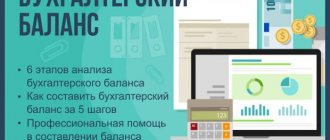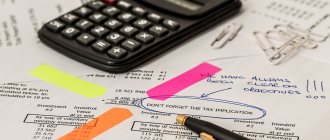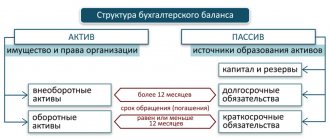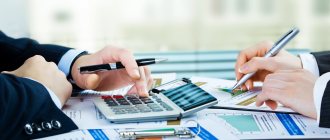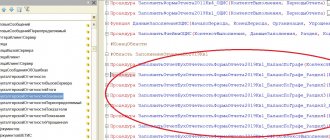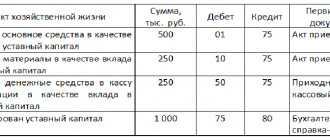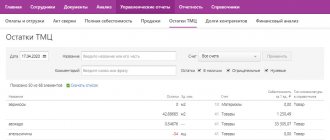Assets and liabilities in the balance sheet
The preparation of financial accounting statements is the direct responsibility of all economic entities conducting accounting.
Some companies and organizations are entitled to keep records in a simplified form, and some are completely exempt. For example, individual entrepreneurs have the right to refuse accounting altogether. But if the enterprise maintains accounting, then reporting becomes inevitable. Reporting is necessary to obtain up-to-date information about the activities, property status and obligations of the entity. Analysis of the information received allows you to quickly and timely make the right management decisions, thereby allowing the enterprise to function smoothly, make a profit, and perform the functions and powers for which it was created.
In essence, reporting is a reflection of property and capital, as well as the sources from which they were obtained, only in monetary terms. The key form of financial reporting is the balance sheet, the unified form of which is approved by Order of the Ministry of Finance No. 66n. For public sector institutions, other forms of reports apply: Orders of the Ministry of Finance No. 33n and 191n. However, regardless of the type of organization, the structure of the balance sheet is practically the same, that is, the forms include the assets and liabilities of the balance sheet.
What is included in the active part of the balance sheet
This is any property of the institution. For example, cash on hand, inventories, fixed assets, buildings, machines and other material and financial assets that directly belong to the company.
The assets of the balance sheet group the current and non-current assets of the enterprise. When preparing reports, it should be taken into account that a balance sheet asset is a grouping of assets according to their useful life, as well as according to the speed (time) of their turnover, that is, liquidity.
In the form of a balance sheet, assets are grouped according to their degree of liquidity. The resources of the enterprise that are the least liquid are indicated first, and then in ascending order. In other words, a balance sheet asset is a grouping of economic resources according to the speed of their circulation into means of payment.
Let us note that the most liquid assets are, of course, cash: cash in the cash register and in the company’s current accounts. And the least liquid include the institution’s fixed assets, intangible assets and long-term financial investments, which cannot be realized quickly and without losses.
The assets of the balance sheet present in grouped form the accounting indicators as of the reporting date. Analysis of these accounting indicators allows us to draw a conclusion about the solvency of the enterprise.
What is it and what is it for?
A balance sheet asset is a section of the balance sheet that shows the property and rights associated with it, funds, and obligations of the institution, including their composition and structure.
The assets of the balance sheet reflect both tangible and intangible property indicators of the enterprise's activities. All property is indicated at its purchase price, taking into account depreciation charges.
The total balance sheet asset must equal the liability to comply with the double entry principle.
Balance sheet assets also include such items that are indirectly related to the property of the enterprise:
- VAT on purchased assets;
- costs that will be taken into account in future periods.
This is always the excess of revenue over expenditure in the final financial statements.
The underlying asset acts as the basis or basis of a particular contract. This is a guarantor of fulfillment of contractual terms and requirements. If a party violates the basic terms of the contract, the BA may be changed or confiscated from the guilty party. An example is securities, real estate and other tangible and intangible property of the organization.
What are liabilities and their classification in the balance sheet
Balance sheet liabilities include all the obligations of the organization that were accepted by it in the reporting period, as well as the sources of the formation of material assets and resources of the institution. In other words, the liability side of the balance sheet is a grouping of assets according to the sources of their formation, that is, liabilities are the sources of formation of material assets, cash, and intangible assets.
The main classification of balance sheet liabilities is the division of liabilities into capital and liabilities.
Capital is recognized as funds allocated by the founders to carry out activities, for example, to purchase property, to provide guarantees to creditors, and to create reserve funds. Liability capital can be own or borrowed. Own funds are capital that belongs to the founders, the creators of the company. And borrowed capital liabilities are funds received from third-party organizations and individuals for temporary use.
Balance sheet liabilities are the company's debt to third parties to fulfill certain financial or property requirements. In turn, liabilities are divided into long-term (more than 12 months) and short-term debts, which must be fulfilled 12 months or earlier.
Rules for drawing up a balance sheet
Let's look at what accounting indicators should be reflected in the active part of the balance sheet. Here is a breakdown of the accounts and indicators of the reporting form:
| Structure | What to include |
| I. NON-CURRENT | |
| Intangible assets | The residual value of the enterprise's intangible assets should be reflected here. Determine the value as the difference between account 04 “Intangible assets” and 05 “Depreciation of intangible assets”. When calculating, exclude values corresponding to data on the results of research and development, as well as information on intangible exploration assets. |
| Research and development results | If an organization conducts research activities and the results of R&D are listed on the balance sheet, then in this section of the balance sheet reflect the residual value of R&D in account 04. |
| Intangible search assets | Filled out by organizations that conduct natural resource development and exploration activities. Economic entities reflect information about such objects on account 08. If an object has a tangible-material shell, then it is a material search asset, intangible ones - without a form, shell, or structure. Please note that for search assets, depreciation is calculated on accounts 02 and 05. |
| Material prospecting assets | |
| Fixed assets | Residual value of fixed assets. Determine the difference between the initial cost of account 01 and accrued depreciation, the balance of account 02. |
| Profitable investments in material assets | Reflect the difference between the balances on account 03 and the accrued depreciation for the corresponding accounting objects (account 02). |
| Financial investments | These are long-term financial investments with a maturity of at least 12 months. For example, reflect the account balance 55 if there are deposits opened for a period of more than 12 months. Also reflect long-term investments in accounts 58 (financial investments) and 73 (loans to employees of the institution). Reduce the balance on account 58 if the organization has created a reserve for the account. 59. |
| Deferred tax assets | Reflect the account balance. 09. Indicators are reflected in accordance with PBU 18/02. |
| Other noncurrent assets | Reflect other types of non-current assets that are not included in the group presented above. Also in this section you can reflect those objects about which it is not necessary to indicate information, but the company considers it necessary to include information in the balance sheet. |
| Total for Section I | The total for the corresponding section is generated. |
| II. NEGOTIABLE | |
| Reserves | Reflect the amount of balances on accounts 10, 11 (minus the reserve recorded on account 14), 15, 16, 20, 21, 23, 28, 29, 41 (minus account 42, if goods are recorded with a markup), 43, 44, 45, 46, 97. |
| Value added tax on purchased assets | Include information about the ending account balance. 19 "VAT". |
| Accounts receivable | To obtain the indicator, debit balances on accounts 60, 62 (both accounts minus the reserves formed on account 63), 66, 67, 68, 69, 70, 71, 73 (minus the data recorded under the item “Financial investments”) are summed up. , 75, 76. Do not include the credit balance in the calculation. |
| Financial investments (excluding cash equivalents) | These are deposits, financial investments, loans to employees with a maturity of less than 12 months. We form account balances. 55, 58, 73. We take into account the reserve on the account. 59, we subtract it if there is a balance. |
| Cash and cash equivalents | The actual money of the company listed in accounts 50, 51, 55 (except for the deposit), 52, 57 as of the reporting date. We reflect the amount of the debit balance. |
| Other current assets | Reflect other types of current assets that are not included in the group presented above. Also in this section you can reflect those objects about which it is not necessary to indicate information, but the company considers it necessary to include information in the balance sheet. |
| Total for Section II | The total value of the section indicators. |
| BALANCE | Sum of section 1 and 2. |
What are they made of?
They include two sections - current and non-current, grouped in ascending order, that is, by the level of liquidity of each indicator.
| Name | Assets on balance sheet - line | Characteristic |
| Non-negotiable | ||
| Intangible | 1110 | Patents, licenses, organizational expenses. |
| Research and development results | 1120 | Inventions, computer software. |
| Search intangible assets | 1130 | Used natural resources and subsoil resources. |
| Search MA | 1140 | |
| OS | 1150 | Buildings and structures, machinery, equipment, land. |
| Profitable investments in MC | 1160 | Property for leasing. |
| Financial investments | 1170 | Investments, participation in the authorized capital of other companies, loans. |
| Deferred tax | 1180 | Account 09 is part of the deferred income tax, which is aimed at reducing the income tax payable in subsequent reporting periods (using PBU 18/02). |
| Other VBA | 1190 | Funds and investments not included in other groups. |
| Negotiable | ||
| Reserves | 1210 | Finished products, raw materials, supplies. |
| VAT on purchased assets | 1220 | The amount of “input” VAT that was not reimbursed from the budget. |
| Accounts receivable | 1230 | The assets of the balance sheet reflect receivables for which payments are expected within or more than 12 months after the reporting date. |
| Financial investments other than cash equivalents | 1240 | Investments in securities of other companies, interest-bearing bonds of state and local loans. |
| Cash and equivalents | 1250 | The total amount of cash equivalents held by an organization. |
| Others | 1260 | OA not included in other groups. |
The totals reflected in line 1600 must correspond to the total result in line 1700.
The concepts of asset and liability are the main components of the balance sheet of an organization, which summarizes materials about the activities and economic situation of the enterprise. Let us consider in more detail what the sections and items of the balance sheet show, as well as what is reflected in the assets and liabilities of the balance sheet.
The sections of the enterprise's balance sheet are shown in tabular form: the left side is Asset, the right side is Liability.
To submit Form 1 of the financial statements to the Federal Tax Service, according to Order of the Ministry of Finance dated July 2, 2016 N 66n, the balance sheet of the enterprise is detailed by item. Detailing by item allows you to highlight the main types of property and liabilities of the enterprise.
In essence, balance sheet items are indicators of assets and liabilities of the balance sheet, which characterize economic assets and sources of formation by individual types. Using the list of balance sheet items, you can always obtain summary indicators for the statements for analyzing the financial activities of the enterprise.
To fill out data on balance sheet items, enterprises use the balances in their accounting accounts as of the reporting date, in accordance with PBU 4/99.
An important rule when drawing up a balance sheet for an enterprise is that the amount of an asset should always be equal to the amount of a liability.
How to correctly prepare a balance sheet liability
Let's present the information in a table.
| Passive | What to include in the liability lines of the balance sheet |
| III. CAPITAL AND RESERVES 6 | |
| Authorized capital (share capital, authorized capital, contributions of partners) | The liability line is formed as information on the credit of account 80. |
| Own shares purchased from shareholders | Reflected based on the amount of account 81 balances formed as of the reporting date. |
| Revaluation of non-current assets | Information is reflected if, during the reporting period, the organization carried out a revaluation of fixed assets and intangible assets. The account balance is formed. 83. |
| Additional capital (without revaluation) | When forming additional capital, the company reflects information on account balances 83. Please note that the amount is indicated without taking into account the revaluation of fixed assets and intangible assets. |
| Reserve capital | In the liability line of the balance sheet, include the balance of account 82 at the end of the reporting period. Reflects information about the formed reserve capital for the organization. |
| Retained earnings (uncovered loss) | When generating the liabilities of the annual balance sheet, use the data from account balance 84. When generating interim reporting, this figure is two account balances 84 (financial result of previous years) and 99 (financial result of the current period of the reporting year). Please note that if the result is a loss, the amount is reflected with a minus. |
| Total for Section III | The total value for the corresponding liability section of the balance sheet. |
| IV. LONG TERM DUTIES | Liability obligations whose maturity exceeds 12 months. |
| Borrowed funds | We reflect the balance of account 67 in the liability side of the balance sheet if the liability period exceeds one year. Please note that interest on loans must be included in the current liabilities section. |
| Deferred tax liabilities | It is an indicator of account balance 77, filled out based on the provisions of PBU 18/02. |
| Estimated liabilities | We reflect the balance of account 96 “Reserves for future expenses” for a period of more than one year. |
| Other obligations | In this line, disclose information about other types of long-term liabilities that were not detailed in other lines of the balance sheet. |
| Total for Section IV | Summarizes the section row metrics. |
| V. SHORT-TERM LIABILITIES | Liability obligations with a duration of less than 12 months. |
| Borrowed funds | The balance of account 66 is reflected. In this case, interest paid on long-term loans should be included in this liability line of the balance sheet. |
| Accounts payable | The indicator is formed as the sum of credit balances for accounts 60, 62, 68, 69, 70, 71, 73, 75, 76. |
| revenue of the future periods | The indicator is equal to the sum of account balances 86 (targeted funding received) and 98 (deferred income). |
| Estimated liabilities | Create a balance on account 96 (reserves for future expenses) for those reserves whose use period is less than 12 months. |
| Other obligations | Here, decipher short-term liabilities that are not included in other liability lines of the balance sheet. |
| Total for Section V | Sum of rows by section. |
| BALANCE | The total value for the liability sections of the balance sheet. |
IMPORTANT!
The values of assets and liabilities are always reflected in monetary terms. Moreover, transactions are recorded exclusively in rubles. If settlements are made in foreign currency, then the transaction must be converted into rubles. The exchange rate approved by the Central Bank of Russia at the time of the economic activity is used.
The balance sheet and other financial statements are prepared in rubles or thousands of rubles. If the company’s turnover is significant, then it is permissible to indicate the amounts in the balance sheet in millions of rubles.
The principle of equal balance
The basic principle of drawing up a balance sheet is that the total value of assets is always equal to the total indicators of liabilities in the report. Of course, arithmetic differences are allowed in exceptional cases. But all identified discrepancies must be justified economically.
The equality of assets and liabilities of the balance sheet is due to the fact that all entries in accounting are reflected using the double entry method. The essence of this method is that when reflecting any fact of economic activity on the balance sheet accounts of an enterprise, an entry is formed in the debit of one account and at the same time in the credit of the corresponding account, but in the same amount.
The principle of double entry expresses the pattern that when one side of the balance sheet, asset or liability, changes, a similar movement must be reflected on the other side. If the amount of an asset increases in an institution, then at the same time the indicator of liabilities or capital - the sources through which property assets were acquired - must increase. Or a decrease in other types of assets is reflected.
For example, an increase in the value of fixed assets. If the company has paid for the cost of the property, then as the indicators of non-current assets increase, the indicator of current assets (cash) decreases. It turns out: the non-current asset increased and at the same time the current asset decreased. For example, a company purchased and paid for materials. In this case, the dynamics of the indicators is reflected within one section of the balance sheet “Current assets”. The value of inventory increases, but the amount of cash decreases.
If a company has received fixed assets (equipment, machinery), but has not yet paid for them, then accounts payable are formed in the company’s accounting. The value of a non-current asset increases, and the amount of debt obligations on the balance sheet also increases. Short-term or long-term - depending on the period of settlements.
Table of composition of active and passive parts
Consider the table of assets and liabilities of the balance sheet:
| The first section is non-current assets | |
| 1110 | Intangible objects |
| 1120 | Results of the carried out developments and studies |
| 1130 | Intangible objects of search nature |
| 1140 | Mat. search objects |
| 1150 | OS objects |
| 1160 | Profitable investments in mat. objects |
| 1170 | Economic Investments |
| 1180 | Deferred tax assets |
| 1190 | Other objects |
| Second section – current assets | |
| 1210 | Company inventories |
| 1220 | VAT amount for purchased objects |
| 1230 | Debts of debtors |
| 1240 | Economic investment (less cash equivalents) |
| 1250 | Cash and cash equivalents |
| 1260 | Other negotiable items |
| The third section is formed reserves and capital | |
| 1310 | UK |
| 1320 | Company shares purchased from shareholders |
| 1340 | Results of revaluation of non-current assets |
| 1350 | DK |
| 1360 | RK |
| 1370 | Retained income (loss) |
| The fourth section – long-term obligations | |
| 1410 | Funds borrowed for a long period of time |
| 1420 | Deferred tax liabilities |
| 1430 | Estimated obligations |
| 1450 | Others |
| Fifth section – short-term obligations | |
| 1510 | Funds borrowed for a short period of time |
| 1520 | Accounts payable |
| 1530 | Deferred profit |
| 1540 | Estimated obligations |
| 1550 | Others |
Similar articles
- Assets and Liabilities
- Long-term assets on the balance sheet
- Tangible and intangible non-current assets
- Permanent asset index: balance sheet formula
- Assets on Balance Sheet
